Domingo 3 de abril de 2011
Financial globalisation in emerging economies: Myths and reality
Fuente:
Vox Eu
Autor:
Eduardo Levy Yeyati
De facto financial globalisation is typically measured a proxy consisting of the ratio of cross-border assets and liabilities (averaged) over GDP. Based on data on cross-border holdings compiled by Lane and Milessi Ferreti (2007), this measure indicates that:
Financial globalisation in emerging markets has been lagging that in more advanced markets;
It has been driven by FDI (and, more recently, equities) at the expense of debt liabilities;
In advanced economies, it is still largely dominated by debt securities (see Figure 11) .
Figure 1. Financial globalisation measures: Emerging markets vs. others
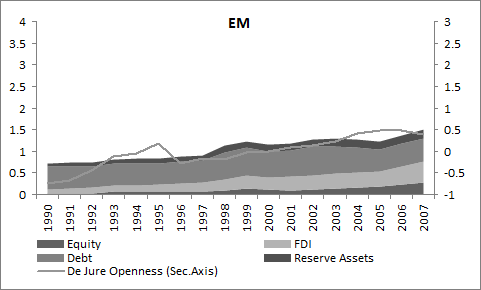
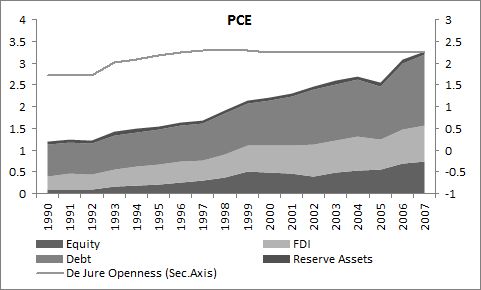
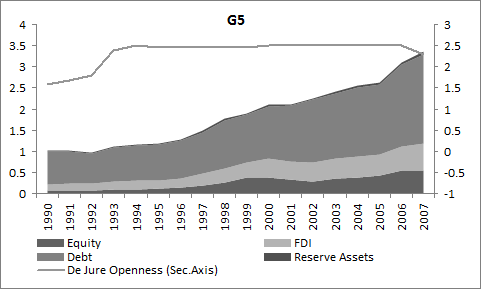
Note: PCE (peripheral core economies): Australia, Canada, New Zealand, Norway, Sweden. G5: France, Germany, Italy, Japan, the U.S. Figures shows country group averages of de facto financial globalisation measures over GDP and de jure measure of financial globalisation for balanced panel data. Only countries with complete data from 1990 to 2007 were used. Source: LMF (2008), WDI, Chinn-Ito.
The last point is more clearly seen by comparing changes in gross foreign positions (Figure 2). The marked decline in debt liabilities (coupled with the build-up of reserves) due to the sovereign deleveraging process in emerging markets contrasts with the growing net debt of G5 countries. More generally, though, Figures 1 and 2 indicate that aggregate financial-globalisation-to-GDP ratios have been growing across the board.
Figure 2. From 1999 to 2007: merging Markets vs. others
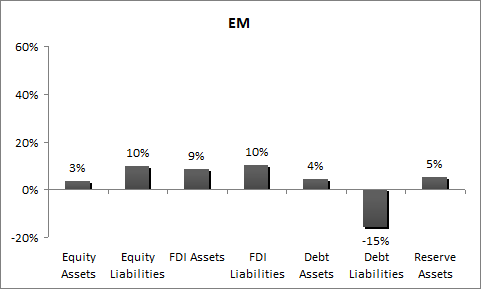
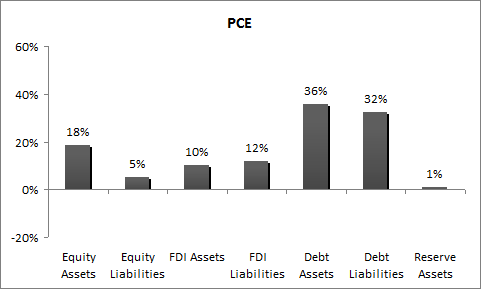
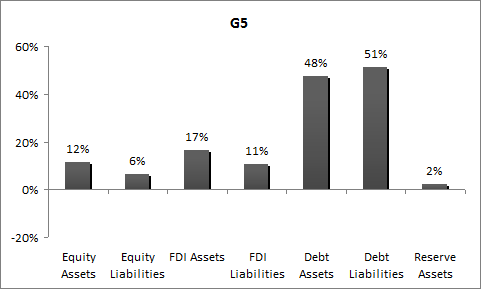
Note: Figures presents changes of de facto financial globalisation measures from LMF (2008) over GDP. Countries in this figure are the same as in F1a. Changes are from 1999 to 2007. Source: LMF (2007), WDI.
For a number of reasons, however, a normalisation by the capitalisation of the local market (marcap) seems more appropriate.
For starters, the role of cross-border holdings and flows as a source of international contagion and exogenous price volatility should be a function of their size relative to the host market.
Moreover, an increasing financial-globalisation-to-GDP, rather than a sign of growing globalisation as it is typically interpreted, could instead be the reflection of a deepening of local markets, regardless of the pattern of foreign participation.
In turn, much of this local market “deepening” may be mechanically driven by valuation changes, due to the equity rally and the real appreciation in emerging markets prior to the 2008 crisis (Levy Yeyati 2011).
As Figure 3 shows, local markets size indeed played a central role in explaining the rising financial-globalisation-to-GDP ratios. For example, 7% out of the 10% increase in equity foreign liabilities is explained by an increase in marcap over GDP, which suggests that, rather than leading the deepening of local equity markets, foreign investors may have accompanied the growth in market capitalisation due to higher equity prices.
Figure 3. Financial globalisation and different normalisations: Merging markets vs. others
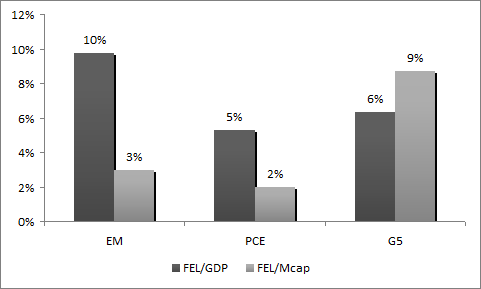

Note: Figures presents changes foreign equity/debt liabilities divided by market capitalization/Total Debt or GDP. Changes are from 1999 to 2007. Source: LMF (2007), WDI, BIS.
Financial globalisation and international risk sharing
In theory, countries with greater financial globalisation should reduce consumption relative to output volatility through international risk sharing. However, recent empirical studies have failed to validate this premise.2
The degree of risk sharing can be proxied by “consumption betas” estimated by the slope of per capita consumption to output growth, both taken as deviations from world levels.
As Figure 4 shows, estimated consumption betas are negatively correlated with financial-globalisation-to-GDP ratios for the advanced-markets sample, but the link is not significant (and of the opposite sign) for emerging markets –in line with the disappointing results reported in Kose et al. (2007).
Figure 4. Risk sharing: Consumption betas vs. financial globalisation
.gif)
Consumption betas and PD
.gif)
Note: Consumption betas as measured by the slope of c_(i)-c_(World) to y_(i)-y_(World), where c and y denote per capita consumption and output growth. *** denotes significance at the 1% level. Source: LMF (2007), WDI.
However, while financial-globalisation-to-GDP ratios may be useful to illuminate the country’s diversification from domestic wealth shocks (alternatively, its exposure to external shocks), they fail to capture the resident investor’s perspective as they ignore the local share of their asset portfolios.3
To address this caveat, we can alternatively estimate portfolio diversification (PD) as the foreign share of the representative resident�s (equity and debt) securities portfolio by combining LMF and marcap figures, such that:
PD (equities + debt securities) = FEA + FDA / [(FEA + equity market cap – FEL) +(FDA + total debt – FDL)],
where FEA and FEL (FDA and FDL) are foreign equity (debt) assets and liabilities.
Using this new measure to track the evolution of portfolio diversification reveals a stark contrast between emerging and advance economies (Figure 5). Whereas portfolio diversification has been growing in the former, in the latter it is not only much lower but declining over time (with the latter possibly reflecting the development of local markets and the associated onshoring of financial intermediation). At any rate, international risk sharing in emerging markets appears to be quite limited.
Reassuringly, when in Figure 4 we substitute portfolio diversification for the standard financial-globalisation-to-GDP measure, we obtain a better correlation with consumption betas, and a negative slope for emerging markets. However, emerging markets results are still far from the theoretical result – not surprisingly, given their rather poor degree of diversification.4
Figure 5. Portfolio diversification
.gif)
Note: This Figure shows the level of portfolio diversification (PD) in 1999 and 2007. PD is measured as (FEA+FDA)/(NFEA+NFDA+Mcap+Total Debt). FEA is foreign equity assets, FDA is foreign debt assets, NFEA is net foreign equity assets and NFDA is net foreign debt assets. Source: LMF (2007), WDI, BIS.
Conclusions
Contrary to conventional wisdom, there appears to be much less financial globalisation in emerging economies than is often assumed (particularly in securities markets), and very low (and declining) levels of portfolio diversification that justify the limited degree of international risk sharing found in recent studies. Emerging markets may have become more globalised, but in terms of financial integration they are still far behind their developed peers.
References
Chinn, Menzie, and Hiro Ito (2008),“A New Measure of Financial Openness”,.Journal of Comparative Policy Analysis, 10(3):309-322.
Kose M Ayhan, Eswar Prasad, Marco Terrones (2007), "How Does Financial Globalisation Affect Risk Sharing? Patterns and Channels", IMF Working Paper 07/238.
Kose, M Ayhan, Eswar Prasad, Kenneth Rogoff, Shang-Jin Wei (2010), “Financial Globalisation and Economic Policies”, in D Rodrik and M Rosenzweig (eds.), Handbook of Development Economics Vol. 5: The Economics of Development Policy, Elsevier.
Lane, Philip R and Gian Maria Milesi-Ferretti (2007), “The External Wealth of Nations Mark II”, Journal of International Economics, 73(2): 223-250.
Levy Yeyati, Eduardo and Tom�s Williams (2011),“Financial globalisation in emerging economies: Much ado about nothing?”, CIF Working Papers 2011-01, UTDT.
1 The figure also includes Chinn and Ito�s (2008) popular measure of de jure (legal) financial globalisation. As can be seen, there is little (if any) correlation between de jure and de facto measures.
2 Whereas Giannone and Reichlin (2006) report an increase in risk sharing for European countries as financial globalisation deepens in the early 1990s as financial globalisation advanced significantly, others find no improvement in international risk sharing in developing economies in the 1990s (Bai and Zhang 2005) and 2000s (Kose et al. 2007, Levy Yeyati and Williams 2011).
3 They also suffer from the already noted valuation bias: a global equity rally would translate into an increase in financial globalisation assets and liabilities over GDP, suggesting an increase in portfolio diversification even if the composition of equity portfolios remains the same.
4 Moreover, the menu of financial assets in middle- to low-income countries is often limited and accessible only to a small population of high-income households.
This article may be reproduced with appropriate attribution.
�
